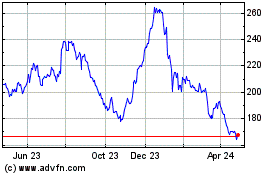Flap May Help Unravel Flight 370's Final Moments
August 12 2016 - 2:40AM
Dow Jones News
CANBERRA, Australia—Investigators believe debris found off
Tanzania in June offers the best new clue to the final moments of
Malaysia Airlines Flight 370, including whether it was under pilot
control.
The Australian Transport Safety Bureau, which has spent weeks
studying the piece—a main flap from a Boeing 777, which experts say
is "highly likely" to be from Flight 370—aims to complete its
analysis in around two weeks. Its conclusions will be part of a
broader report to be reviewed by experts, including from Boeing
Co., before being released to the public.
Investigators continue to seek answers to one of the world's
biggest aviation mysteries even as governments prepare to suspend
the search after months spent scouring the floor of the southern
Indian Ocean failed to find any trace of the plane. Flight 370
vanished from radar en route to Beijing from Kuala Lumpur on March
8, 2014, with 239 people on board.
Authorities have long believed the plane wasn't under human
control at the time of its apparent crash, based on communications
between the aircraft and an Inmarsat PLC satellite. That
communications data—central to fixing on a 120,000 square-kilometer
search area, more than 90% of which has now been covered—suggest
Flight 370 was plummeting at a rate of at least 12,000 feet a
minute when it entered the water.
However, another theory—that the plane was in a controlled glide
following a loss of engine power—hasn't been ruled out, though
authorities consider it less likely. While either theory would lead
to largely the same search area, the edges would vary; a simulation
shows the aircraft, starting from 40,000 feet, could have gone an
extra 140 miles if under control.
Peter Foley, program director for the Operational Search for
Flight 370 at the ATSB, said the main flap is particularly
significant because damage analysis may determine how it broke off
the plane. Unlike other parts recovered so far, such as the
flaperon found on Ré union Island and being examined in France,
the main flap is deployed manually.
"It has to be deployed by a human, from the cockpit," Mr. Foley
said in an interview. "And you have to have hydraulic power to do
so."
The flap, its honeycomb interior clearly visible, now sits on an
office desk in a room at the ATSB's Canberra headquarters that
resembles an ordinary garage more than a sterile laboratory. Among
the clues being sought by investigators: impact marks where
hydraulic actuator arms were situated—which Mr. Foley said would
help determine whether they were in a normal housed position or
deployed at impact—and damage to the material within the flap,
which could indicate the speed and angle of the aircraft as it hit
the water.
"The good thing about engineering is that it's generally pretty
conclusive, it's either one way or it's not that way," Mr. Foley
said. "The evidence points you in a direction."
A recent analysis by Australian defense scientists of burst
frequency signals from Flight 370 to satellites indicated the
aircraft had been descending fast, likely in an automated series of
swooping dives called fugoids. The high speed points away from a
gliding descent under pilot control, Mr. Foley said.
"So in a sense, quite recently, it put a line under our thinking
in terms of alternate scenarios," he said.
While analysis of the main flap may provide a strong indicator
about what happened when the plane entered the water, it offers
fewer clues about Flight 370's whereabouts. Australian ocean
current modeling has showed some debris could have drifted
thousands of miles west toward Africa from the search area.
Mr. Foley said the flap analysis would be passed to the
governments of Australia, Malaysia and China to decide whether it
justifies extending the search, which the three countries said on
July 22 would be suspended if the current area doesn't yield
results.
"Governments are at the point where they need us to present them
with some fairly compelling evidence of where that aircraft is
before they are going to extend the search," said Mr. Foley. "We're
working harder to find that crucial piece of evidence. We need
something that is going to give us something pretty conclusive
about what happened at the end of the flight, where that aircraft
impacted the sea."
Authorities haven't drawn firm conclusions around why the flight
veered sharply off its intended flight path, turning hard to the
west and then flying steadily south toward a remote corner of the
Indian Ocean.
"Unfortunately, this is not an exact science," Australian
Transport Minister Darren Chester said in an interview. "We are
pushing the boundaries of aviation research and analysis, and in
many ways we are pushing the boundaries of human endeavor to search
one of the most inhospitable places on the planet, in water six
kilometers deep."
"The fact that we are doing additional drift modeling and
continuing to analyze satellite modeling, and revisit all the
evidence and data, is an indication that we are not giving up on
this search," he said.
Write to Rob Taylor at rob.taylor@wsj.com and David Winning at
david.winning@wsj.com
(END) Dow Jones Newswires
August 12, 2016 02:25 ET (06:25 GMT)
Copyright (c) 2016 Dow Jones & Company, Inc.
Boeing (NYSE:BA)
Historical Stock Chart
From Mar 2024 to Apr 2024

Boeing (NYSE:BA)
Historical Stock Chart
From Apr 2023 to Apr 2024
